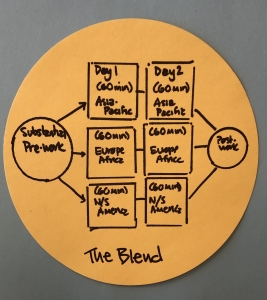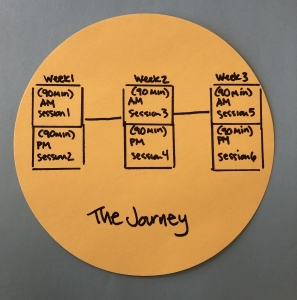The Many Splendid Shapes and Sizes of Virtual Workshops
There has been a raft of flipped workshops recently where F2F events have been redesigned to be held virtually, and it is fascinating what a rich diversity of designs there are. Some of them have been reworked as big blocks of synchronous together time that aim to closely mimic the programme of the original F2F workshop with some minor modifications, such as adjusting the time to make it more comfortable for participants on different continents, and reducing the number of days for example. Others are dramatically reducing the “contact” time and pushing workshop tasks into the days before and after the online meeting, undertaken by participants individually. Yet another model is spreading the engagement out over weeks, with scheduled touch points that pick up different themes of the original event – and many, many more!
As we are all learning right now, I thought I’d share some details of a few of these models that I am working on right now, in case they might be useful for other designers and organizers who are in the process of flipping their workshops.
Model 1: The Block
I have one of these coming up which was originally a 3-day F2F workshop, scheduled to be held daily from 09:00 – 18:00, with one evening session. Now in its virtual incarnation, it is two days long, and will be held from 11:30-17:30 (Central European Time) to accommodate both European and North American participants (and no “night” session). To pare down the work, we needed to go back to the original objectives and select those that needed to be accomplished now, and those that could wait for a subsequent F2F, or be taken into a set of topical conference calls later on. We also added some pre-work, but most of the work would still be done together in the virtual sessions.
Even with these modifications, this virtual workshop block will be a heavy lift for participants. We have the traditional 90-minute session lengths, with lunch and afternoon coffee breaks scheduled to relieve people from their screens. During this free time, we will invite people to stay connected if they wish, to chat together informally while they eat and have coffee. To keep things interactive and lively, we have a diverse mix of activities, including a number of break outs, supported with google docs to capture outputs from breakouts and other small activities (polls, stretching, etc.) to keep things moving.
This format of this workshop is relatively close to our original F2F agenda, and I think in some cases the makeover of a F2F workshop to a virtual using this model can work well with a few caveats. This would include a rather small group (we are 20) of very dedicated people (this will be tiring so need to manage their attention) with a well- defined task (we are finishing a co-creation project to develop a set of guidelines). I think the fact that the majority of this mixed stakeholder group has worked together before will make the social dynamics side work. We invested significantly in building social capital in our first F2F workshop that we can draw on now for trust, commitment and creativity. For this workshop we are using zoom and will have two facilitators supporting the team in their work, one of which will operate the technical aspects (splitting people into breakouts, launching polls, etc.)
Model 2: The Blend
Not many of my flipped workshops are taking this compact block shape. For others we are opting for shorter synchronous meetings (where people are all together) and taking a lot of the planned work out of that full contact time. We are blending substantive pre- and post-meeting work that is asynchronously completed (e.g. undertaken by individual participants whenever they want), with the meeting times for synchronous engagement and discussion.
Here’s an example: For one previously scheduled two-day F2F workshop where we were gathering feedback to guide a consultation process, we asked the 40+ participants to review and comment on a google doc in advance of the meeting, and to answer 3 higher-level strategic questions about the document on a separate google sheet before we met online. As participants were located all over the world, we conducted our workshop through three 90-minute meetings held each day for two consecutive days – one call for participants in the Asia Pacific region, one for Europe/Africa/MENA, and one for North America, Latin America and the Caribbean. To support these virtual meetings, we made three identical copies of the document to comment upon and labeled each by region. The google sheet with the strategic questions had the instructions on the first sheet and then three tabs, labeled by region, each with an identical set of strategic questions. Note that we sent out the links to the google docs, but also sent the files as attachments in word and excel. Some people are not able to use google docs due to their location or institution, or not familiar with them, so they had the option.
The calls themselves were used to present an overview of the document as a reminder, and then an analysis of the comments and feedback received. We asked for more feedback and could ask specific probing questions on each region’s responses where we had them. With the documents split by region, we could easily see what the people from the region on the call said, so we could seek further clarification and detail on their comments efficiently as need be.
For the Day 2 meetings, we synthesized what we had heard on the Day 1 across the regions, and identified five topics that emerged across the calls to bring back to the groups. For example, we had a couple of points that needed further clarification, others where the different groups offered conflicting advice, etc. The second call allowed us to share what we had heard and to go further, bringing in some of the good ideas across the different calls.
It is true that not everyone attending this larger workshop did the pre-work, especially at this time when people are working from home and juggling many things. Many did, but said they would value more time to reflect on the comments others had made, or in order to do some internal consultation in their organizations. As such, we are leaving the documents open for another week to capture as much of their input as possible, let them build on other’s ideas, and reflect further. Also, if someone could not join the calls for some reason, or did not want to speak out on the call, they are able to contribute their ideas in this way. This was our plan, and was also requested by participants.
Our workshop goal was to get this senior group’s comments and ideas, so we needed to make this as easy as possible for participants. This workshop was the first step in a longer consultation process so it had to generate good quality input, in addition to being satisfying for the participants. This model blends asynchronous work before and after the call, with shorter synchronous virtual meetings. It was run by one facilitator on the Go-to-Meeting platform.
Model 3: The Journey
The third model that we’re working on flips a very large-scale 300+ community workshop into virtual space by spreading the content out over three weeks. Six interactive webinars will be held in total. Once a week on the same day, two webinars will be held on the same day, one in the late morning and one in early afternoon to accommodate as comfortably as possible the largest number of the global participant group.
As this was more of a conference-style gathering for a larger group, even with many interactive elements in the F2F format, there was a lot of content to work with. This gathering will be postponed until early 2021, so we are pulling out the good practice exchange, community updating and storytelling aspects into this webinar format and featuring the work of different community members. We will still have interactivity through the introduction of a back chat polling tool (polleverywhere for example), as well as a crowdsourcing exercise to draw ideas from the group. This latter task will be introduced in the first webinar and the results analyzed and presented in the last webinar two weeks later. For this we are exploring Zoom, and will have a facilitator and a host of moderators and technical resource persons.
So there you have it, what started out as three F2F workshops planned to be held over 2 and 3 days, have ended up as three dramatically different models of virtual workshops. The diversity of options makes it exciting to re-design in virtual space.
Design Questions
Your choice also depends on the design parameters you are working with. Once you know your objectives and desired outputs, you ask:
- How many people?
- Where are they located (time zones)?
- What kind of connectivity do they have? (Can they support video, calls, other?)
- How committed are they to your process and the goals?
- Do they know each other? Do they need to?
- What experience do they have with virtual work? Do you use some platform already?
- Will people do asynchronous work? E.g. Will they devote the time if we give them tasks to do before and after the contact time?
Then as a facilitator, you use your design skills and creativity to put together your virtual workshops, which, just like their F2F counterparts, come in a delightfully wide variety of shapes and sizes.










Thank you BGL++
Hi Gillian,
Thanks for sharing as always! Have you considered Thought Exchange for your online crowdsourcing tool? I just got a license and did my first exchange. I’d be happy to host one for you if you like the idea. I’m experimenting however looks promising. Check it out and let me know. Michelle